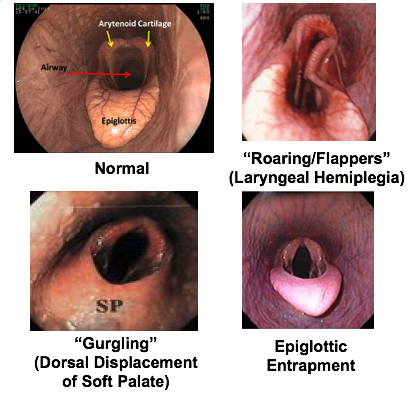Why Is My Horse Struggling to Breathe?

When horses breathe hard during exercise, the soft tissue over the nasal passage is sucked in, reducing airway diameter, restricting airflow and potentially leaving the horse struggling to breathe. The spring-like action in FLAIR® Strips gently supports the nasal passages to reduce soft tissue collapse, improving airflow into the lungs and providing a remedy for horse breathing problems.
FLAIR Strips have been proven to reduce peak inspiratory pressure, which is the amount of negative pressure required to draw air into the horse's lungs.
How FLAIR Strips Relieve Horse Breathing Problems
Whether horses have ongoing and recurring problems that leave them struggling to breathe or not, FLAIR Strips are trusted by riders to help alleviate horse breathing problems. Because a horse’s airway is one long tube from their nostrils to their lungs, reducing airflow resistance in one part of the airway positively impacts other structures in the tube. Therefore, FLAIR Strips can be used to help alleviate long-term horse breathing problems, even if they are not immediately related to the nasal passages.
While the clinical studies done on FLAIR Strips have focused primarily on exercise-induced pulmonary hemorrhage (EIPH or lung bleeding), airflow resistance, energy consumption, and fatigue. However, anecdotal data and comments by several equine research institutions believe that FLAIR Strips provide benefit for additional and recurring horse breathing problems or respiratory issues, such as:
-
Paralyzed arytenoid cartilage (“roarer” or “flapper”)
-
Heaves, chronic obstructive pulmonary disease (COPD), recurrent airway obstruction (RAO), Inflammatory airway disease (IAD) and asthma
-
Dorsal displacement of the soft palate (DDSP)
Here's why it is believed that FLAIR Strips are beneficial for horses that have a respiratory condition and are struggling to breathe:
When galloping, horses only take air in through their nasal passages in the part of the upper airway. FLAIR Strips work by supporting the nasal passages to improve airflow. By improving flow at the nasal passages, flow is improved throughout the entire tube from nostrils to the lungs; that is, any obstruction at one point along the tube can be benefitted by increasing flow at other locations along the tube.


For horses with paralyzed arytenoid cartilage (“roarers”):
Vets and owners report that using FLAIR Strips on horses that have a paralyzed arytenoid cartilage (“roarer” or “flapper”) and those who have had surgery for the condition make less noise when breathing. So, while FLAIR Strips don't work directly at the throat, they do reduce noise and may be beneficial for horses with paralyzed arytenoid cartilages.
For horse with Heaves, COPD, RAO, IAD, Asthma:
Heaves, COPD, RAO, IAD, and asthma are all forms of lower airway disease. Significant literature is available on these conditions thanks to AAEP & The Horse. In general, all of them can have an impact on lung compliance. This means the elasticity of the lung (the ability to expand and contract) is reduced, increasing the effort required to breathe air into the lungs. A horse struggling to expand and contract his lungs will benefit by reducing resistance to breathing anywhere along the upper and lower airway.
For horses with DDSP:
There is data showing that many conditions of the upper airway, including dorsal displacement of the soft palate (DDSP), are more likely to occur when combined with any other restriction to airflow in the upper airway, including nasal collapse.
We do receive significant feedback from horse owners and veterinarians who use FLAIR Strips as a remedy for horse breathing problems. Whenever your horse has health issues, we recommend that you consult with your veterinarian
Extended Use For Horses With Breathing Problems
If extended wear might be helpful for your horse, FLAIR Strips are safe to leave on for longer than a day due to the use of medical-grade adhesive. The horse may rub and dislodge parts of the Strip, and with excessive heat and sweating, good adhesion over longer periods of time might diminish, but, as long as the Strip has good adhesion over the majority of the nose, it is beneficial for extended use. Even if the edges are lifting, as long as the main portion of the Strip is adhering, it will support the air passages correctly.
Learn more about how FLAIR Strips help support equine athlete health or purchase your own FLAIR Strips by browsing our online store.





